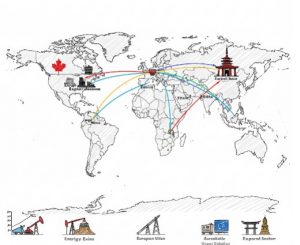Top U.S. Exports by Revenue
- Machinery & Industrial Equipment ($213B/year)
- Includes aircraft engines, turbines, and construction machinery.
- Key Players: Caterpillar, General Electric, Boeing.
- Mineral Fuels (Oil & Gas) ($195B/year)
- Crude oil, refined petroleum, LNG.
- Key Players: ExxonMobil, Chevron, Cheniere Energy.
- Pharmaceuticals ($110B/year)
- Branded drugs, vaccines, and biotech products.
- Key Players: Pfizer, Johnson & Johnson, Merck.
- Aerospace Products ($99B/year)
- Commercial aircraft, helicopters, satellites.
- Key Players: Boeing, Lockheed Martin, Raytheon.
- Automobiles & Parts ($85B/year)
- Luxury vehicles, EV components, engines.
- Key Players: Tesla, Ford, General Motors.
- Medical Equipment ($73B/year)
- MRI machines, surgical tools, diagnostics.
- Key Players: Medtronic, Abbott Laboratories.
- Semiconductors ($63B/year)
- Advanced chips for AI, IoT, and defense.
- Key Players: Intel, NVIDIA, Qualcomm.
- Agricultural Products ($60B/year)
- Soybeans, corn, dairy, and meat.
- Key Players: Cargill, Archer Daniels Midland.
Emerging Trends & How to Capitalize
1. Energy (Oil, Gas, Renewables)
- Trends:
- U.S. LNG exports surged due to EU demand post-Ukraine war.
- Renewable energy tech (solar panels, battery storage) is growing.
- Opportunities:
- Invest in LNG infrastructure (export terminals, shipping).
- Partner with clean hydrogen or carbon-capture startups.
- Export renewable tech to Asia and Europe.
2. Advanced Manufacturing & Machinery
- Trends:
- Automation (robotics, 3D printing) boosts efficiency.
- Reshoring of critical manufacturing (semiconductors, EVs).
- Opportunities:
- Supply automated systems to factories in India, Mexico, and Vietnam.
- Leverage the CHIPS Act to build semiconductor supply chains.
3. Pharmaceuticals & Biotech
- Trends:
- mRNA vaccines and personalized medicine.
- AI-driven drug discovery.
- Opportunities:
- License U.S.-developed drugs to emerging markets (Africa, Southeast Asia).
- Partner with biotech firms for contract R&D or manufacturing.
4. Aerospace & Defense
- Trends:
- Demand for military drones and satellites (Ukraine, Taiwan tensions).
- Sustainable aviation fuels (SAF) for decarbonization.
- Opportunities:
- Supply components for drone manufacturing.
- Invest in SAF production to meet airline sustainability targets.
5. Agribusiness
- Trends:
- Organic and plant-based food demand in Europe/Asia.
- Precision agriculture (AI, drones) for higher yields.
- Opportunities:
- Export non-GMO crops or plant-based proteins.
- Sell agri-tech tools (soil sensors, drone analytics).
6. Semiconductors
- Trends:
- AI and quantum computing require advanced chips.
- U.S.-China tech war spurs demand for secure supply chains.
- Opportunities:
- Build fabrication plants (fabs) in the U.S. with CHIPS Act subsidies.
- Export chip-making equipment to allied nations (Japan, South Korea).
How to Break Into These Markets
- Leverage Trade Agreements:
- Use USMCA (North America) and Indo-Pacific Economic Framework (IPEF) to reduce tariffs.
- Partner with Local Distributors:
- Collaborate with logistics firms in high-growth regions (e.g., India, Brazil).
- Adopt Sustainability:
- Certify products as “green” to meet EU/Asia ESG standards.
- Focus on Tech Integration:
- Embed IoT/AI into machinery or medical devices for premium pricing.
- Seek Government Support:
- Apply for EXIM Bank loans or SBA export grants.
Key Challenges
- Geopolitical Risks: Tariffs (e.g., U.S.-China trade war), sanctions (Russia).
- Supply Chain Bottlenecks: Semiconductor shortages, port delays.
- Regulatory Hurdles: FDA approvals for pharma, FAA certifications for aerospace.
Final Takeaway
The U.S. remains a global export powerhouse, but success requires aligning with megatrends: energy transition, automation, and AI-driven innovation. Start by targeting niche markets (e.g., renewable tech in Europe or agri-tech in India) and build partnerships to mitigate risks. Stay agile to adapt to shifting trade policies and consumer demands

